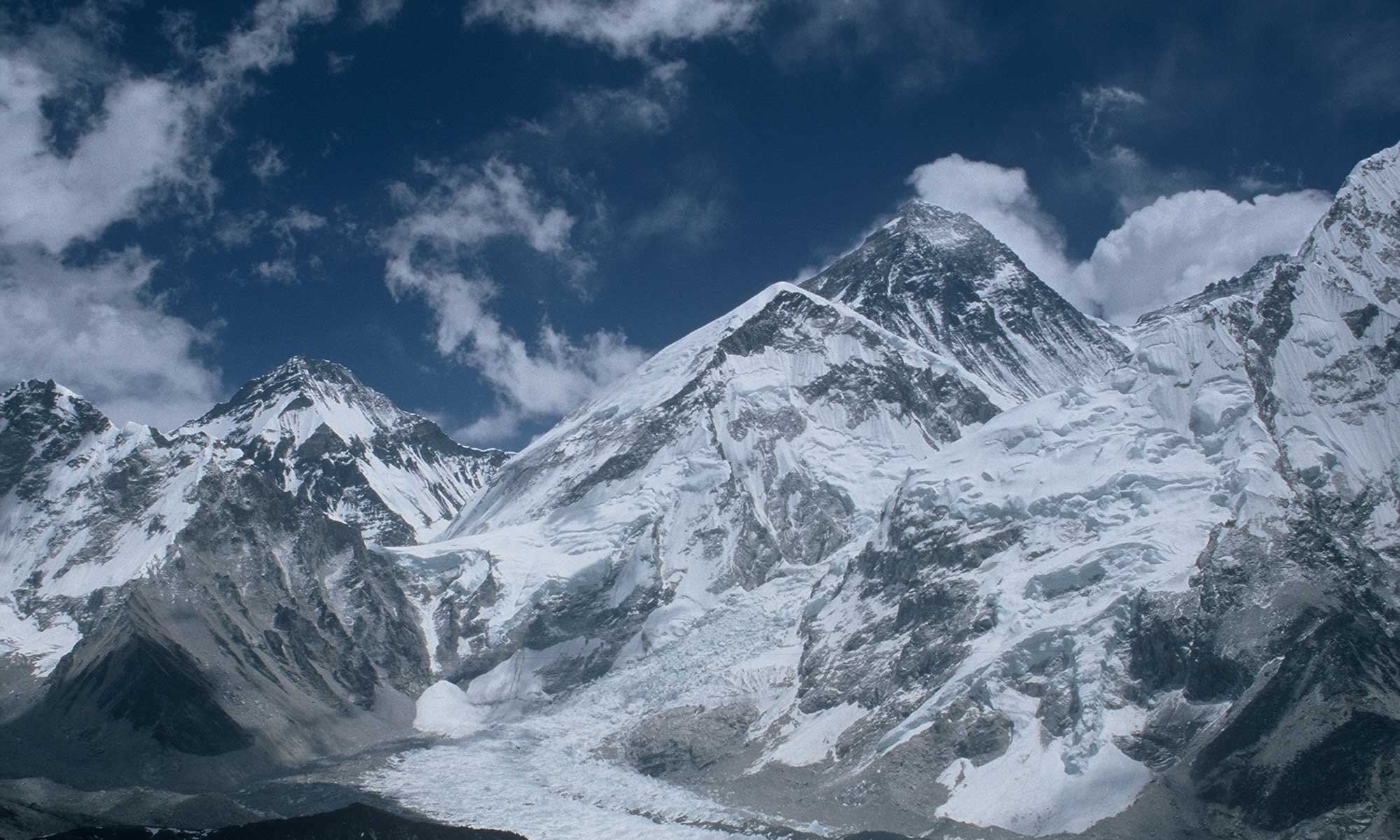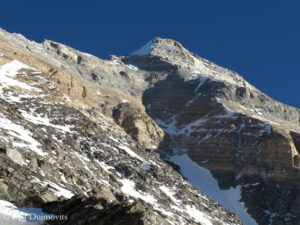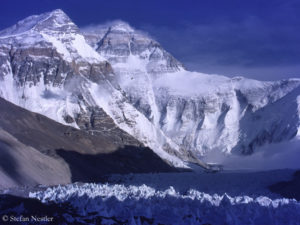His girlfriend at the time hardly recognized him. “It seems that a drunk came down from the col and not the same man who left four days ago,” Nena Holguin wrote in her diary. “He looks at me with tears in his eyes. His face is yellow, his lips are chapped and frayed.” Reinhold Messner was all run down, physically and mentally too. This alpinistic stroke of genius had demanded everything from him.
Again he had pushed a limit, made possible what others had thought impossible. In the middle of the monsoon, the South Tyrolean had scaled Mount Everest via the Tibetan north side: climbing solo, without bottled oxygen, on a partially new route: Messner crossed the north flank below the Northeast Ridge, then ascended through the Norton Couloir and finally reached the highest point at 8,850 meters in the afternoon of 20 August 1980, the third day of his ascent.
For a long time, the first man to climb all 14 eight-thousanders described the Everest solo as the “icing on the cake” of his mountaineering career. Now, four decades later, Reinhold Messner classifies his pioneering achievement differently. I spoke with the 75-year-old.
Reinhold Messner, do you still sometimes think of that 20 August 1980, when you reached the summit of Mount Everest after you had solo-climbed it?
Much less than I still think of Nanga Parbat, which I climbed ten years earlier. The story 50 years ago, the tragedy of my brother’s death, has remained in my consciousness much more deeply than the solo ascent of Everest. Nevertheless, the solo on Mount Everest was a kind of final chord in my development from Nanga Parbat in 1970 to Hidden Peak in 1975 (on Gasherbrum I, Messner succeeded with Peter Habeler in the first ascent of an eight-thousander in Alpine style), Everest without breathing mask and the solo on Nanga Parbat (both in 1978) to K2 (in 1979). After that I started sprinting to scale all eight-thousanders (he completed his collection in 1986, always having climbed without bottled oxygen).
You wrote in one of your books about the last meters during your Everest solo: “It was an endless torture”. How wiped out were you back then?
In 1980 on Everest, I was more wiped out than ever before and not even after that. I had fantastic weather, was very well acclimatized and made very good progress in the lower part of the mountain. That made me feel cheerful and confident. A few hundred meters below the summit, however, the weather closed up. Fog crawled up from the south side, spilling down over the ridges and the summit to the north. I was suddenly afraid that I would lose orientation. Tiny snowflakes were drizzling.
If I hadn’t found my trail, which only broke a little into the firn, when going down, I would have been lost up there. So I tried to climb a little faster. But that didn’t work because the oxygen partial pressure was so low up there. So on the one hand there was the concern that it would become dangerous and on the other hand the thin air that slowed, slowed, slowed me down. I was so exhausted at the summit that I just let myself fall into the snow and dozed off. Fortunately, after an hour of puffing – that’s all it was – I had the strength to get up again and to descend.
Your Everest solo is considered a milestone in Himalayan climbing. Would you describe the project as the climax of your sporting career?
No, the Nanga Parbat solo was more important because it was the first step into this dimension to master an eight-thousander all by yourself. It’s all about not being able to share your worries and fears. If I have a climbing partner, the whole thing becomes emotionally and psychologically easier to bear. But it remains a grind. The thin air, the panting, the cold air filling your lungs, it’s just suffering. You have to have suffered that yourself to be able to recount it.
The Everest solo climb was not the most difficult, but the most exhausting thing I did – but only on the summit day. Then I came out of the fog again. And the descent, especially when there is monsoon snow, is many times less strenuous than the ascent.
It has remained the only successful solo project on Everest to date. Why is it like this from your point of view?
Of course, there were some people who have also climbed up the slope alone, however 50 people in front of them, 100 people behind them. Among them was Alison Hargreaves (the British died on K2 in 1995 aged 33), for me the best female mountaineer ever. But this is not a true solo climb. Doing a solo, I go into a big flank of a mountain completely on my own. And that is difficult because we humans are not made for being alone.
It is comparatively easy to bivouac alone on a wall in the Dolomites one night and continue climbing the next day. I had to learn that too. But it is much more difficult to go out into the wilderness alone and be cut off from the rest of the world for weeks on end. That is difficult to bear.
Last winter the German Jost Kobusch tried a solo without bottled oxygen via the West Ridge of Everest. He reached an altitude of almost 7,400 meters. Do you think a solo ascent in winter is realistic?
Yes, there are mountaineers who are perhaps equal to the challenge. But one thing is certain, Kobusch will not be able to do it. He has little or no idea of what he is actually doing. He is also of the opinion that 500 years ago the Sherpas immigrated from Tibet to Nepal via Lho La, a pass he was on. If someone doesn’t know that it was Nangpa La they came over and not Lho La, where it is not possible at all, then he has no historical-geographical idea about Mount Everest.
This spring, Everest remained a lonesome mountain. What all appeals to reduce the number of summit candidates failed to achieve, the corona crisis brought about. Do you think it could have a lasting effect?
Unfortunately, it will not have a lasting effect. The Sherpas need this work because it’s what they do for a living. And the government collects the fees for the permits – 11,000 dollars each, soon maybe even 25,000, that is still under discussion. The Sherpas have Everest under control today. They are the best mountain guides in the Himalayas you can imagine. Some of them have climbed Everest a dozen or even two dozen times. A Gurkha, Nirmal Purja, has not only scaled Everest, but all 14 eight-thousanders in just under seven months. But this was only possible because all these mountains are put in ropes and chains. Tourist paths are prepared so that as many people as possible can be brought up.
Now there was a year of silence on Mount Everest, and that is good. But the pressure will grow, as will the demand from tour operators to book Everest. And so the offer will also increase again. The amenities in the base camp and further up will increase, so it will be possible for more and more people to climb to the roof of the world. That’s up to them, but this is not traditional alpinism. Traditional alpinism is something completely different. Kobusch wanted to do it, but he should have known in advance that with his experience today he doesn’t stand a chance. If he learns a lot and really understands what alpinism is, and doesn’t just read and parrot, then Kobusch, physically certainly quite fit, also has the chance to finish a solo ascent on Everest. It is easy to announce the greatest adventure story of all times, but a priori already knowing that it will only turn into a ridiculous attempt.





